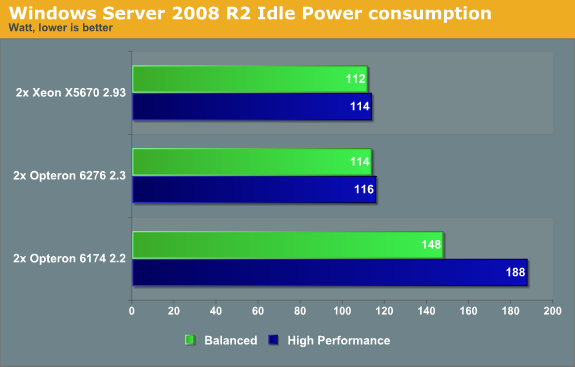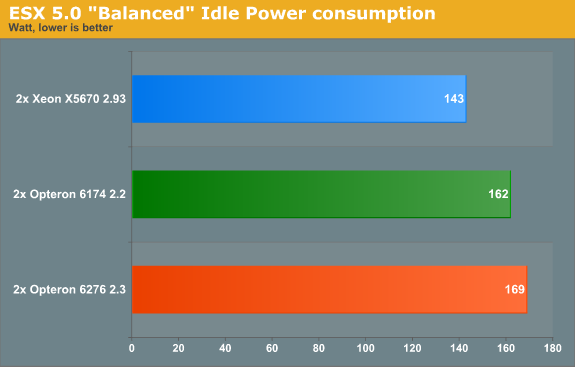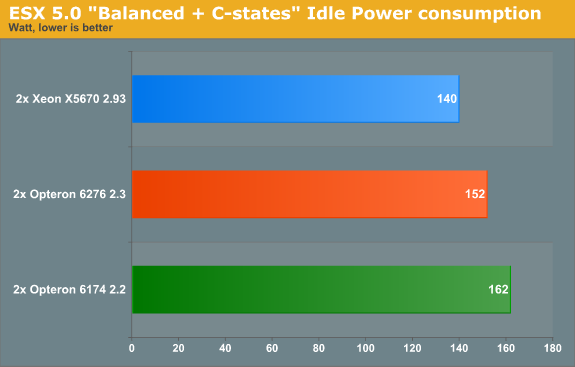Bulldozer for Servers: Testing AMD's "Interlagos" Opteron 6200 Series
by Johan De Gelas on November 15, 2011 5:09 PM ESTMeasuring Real-World Power Consumption, Part Two
First, we wanted to check if the Interlagos power management problems were specific to ESXi. Therefore, we measured the power consumption when running Windows 2008 R2 SP1 x64. We set the power management policy to "Balanced" and "High Performance".

Wow, that is a lot better! The core gating of the Bulldozer cores is first rate, as good as the Xeons of today. Idle power draw is a serious problem of the Opteron 6174: it is between 30 to 63% higher! So even if the ESX scheduler does not really understand how to handle the power management features of the "Bulldozer" Opteron, the question remains why the Opteron 6276 cannot even beat the Opteron 6174 when running idle in ESXi.

While I was testing the power consumption on Windows, my colleague Tijl Deneut dug up some interesting information about the ESX power manager. The Balanced Power policy (the default power policy for ESXi 5) is rather simple: it uses an algorithm that exploits only the processor’s P-states and C-state C0 and C1. So "Balanced" does not make very good use of the deeper sleep states. So we went for custom, which is the same as "Balanced" until you start to customize of course. We enabled the other C-states and things started to make sense.

After some tinkering, the Opteron 6276 does quite a bit better and saves 17W (10%). The Xeon reduces power consumption by 3W, and the Opteron 6174's less advanced power management is not able to save any more power. So enabling the C-states is an important way to improve the power consumption of the Opteron "Interlagos" with ESXi 5.










106 Comments
View All Comments
mino - Wednesday, November 16, 2011 - link
IT had most likely to do with you running it on NetBurst (judging by no VT-X moniker).As much to do with VT-X as with a crappy CPU ... wiht bus architecture ah, thank god they are dead.
JustTheFacts - Wednesday, November 16, 2011 - link
Please explain why there is no comparison between the latest AMD processors to Intel's flagship two-way server processors: the Intel Westmere-EX e7-28xx processor family?Lest you forgot about them, you can find your own benchmarks of this flagship Intel processor here: http://www.anandtech.com/show/4285/westmereex-inte...
Take the gloves off and compare flagship against flagship please, and then scale the results to reflect the price differece if you have to, but there's no good reason not to compare them that I can see. Thanks.
duploxxx - Thursday, November 17, 2011 - link
Westmere EX 2sockets is dead, will be killed by own intel platform called romley which will have 2p and 4p.it was a stupid platform from the start and overrated by sales/consultants with there so called huge memory support.
aka_Warlock - Wednesday, November 16, 2011 - link
I think you should have done a more thorough VM test than you did. 64GB RAM?We all know single threaded performance is weak, but I still feel the server are underutilized in your test.
These CPU's are screaming heavy multi threading workloads. Many VM's. Many vCPU's.
What would the performance be if you had, say, at least 192GB of RAM and 50 (maybe more) VM's on it?
And offcourse, storage should not be a bottleneck.
I think this is where his 8modules/16threads cpu would shine.
A dual socket rack/blade. 16modules/32 threads.
Loads of RAM and a bounch of VM's.
iwod - Wednesday, November 16, 2011 - link
It is power hungry, isn't any better then Intel, and it is only slightly cheaper, at the cost of higher electricity bill.So unless with some software optimization that magically show AMD is good at something, i think they are pretty much doomed.
It is like Pentium 4, except Intel can afford making one or two mistakes, but not with AMD.
mino - Wednesday, November 16, 2011 - link
Then the article served its purpose well.SunLord - Wednesday, November 16, 2011 - link
So is the AMD system running 8GB DDR3-1600 DIMMS or 4GB DDR3-1333? Because you list the same DDR3-1333 model for both systems and if the Server supports 16 DIMMs well 16*4 is 64GBJohanAnandtech - Thursday, November 17, 2011 - link
Copy and paste error, Fixed. We used DDR-3 1600 (Samsung)Johnmcl7 - Wednesday, November 16, 2011 - link
I have wondered about this, with more cores per socket and virtualisation (organising new set of servers and buying far less hardware for the same functionality) so I'd have thought in total less server hardware is being purchased. Clearly that isn't the case though, is the money made back from more expensive servers?John
bruce24 - Wednesday, November 16, 2011 - link
While sure which each new generation of server you need much less hardware to do the same amount of work, however worldwide people are looking for servers to do much more work. Each year companies like Google, Facebook, Amazon, Microsoft and Apple add much more computing power than they could get by refreshing their current servers.